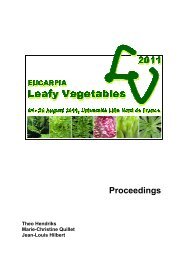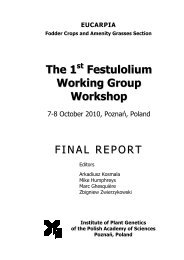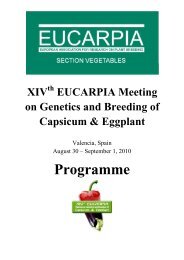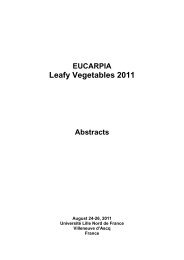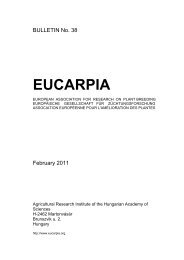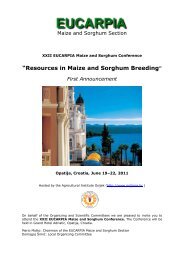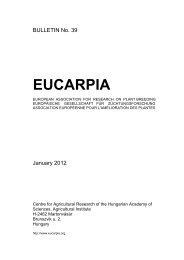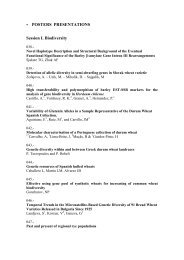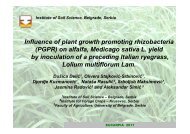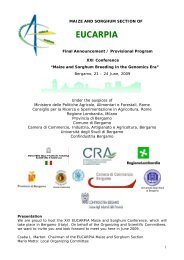Plant breeding for organic and sustainable, low-input agriculture
Plant breeding for organic and sustainable, low-input agriculture
Plant breeding for organic and sustainable, low-input agriculture
Create successful ePaper yourself
Turn your PDF publications into a flip-book with our unique Google optimized e-Paper software.
Evolution of diversity during 20 years of mass selection on ‘Pigarro’, a Portuguese<br />
improved maize population with fasciation.<br />
Pedro Mendes Moreira 1 , Carlota Vaz Patto 2 Silas E. Pêgo 3 , Arnel R. Hallauer 4<br />
1 Escola Superior Agrária de Coimbra, Departamento de Fitotecnia, Coimbra, Portugal;<br />
2 Instituto de Tecnologia Química e Biológica, Universidade Nova de Lisboa, Portugal;<br />
3 Instituto Nacional de Recursos Biológicos/EAN, Oeiras, Portugal;<br />
4 Iowa State University, USA.<br />
Maize was introduced in Portugal, after America’s discovery by Columbus. Maize adaptation to<br />
a diversity of l<strong>and</strong>scape, climate conditions <strong>and</strong> people’s needs, took place during five centuries.<br />
These adaptations led to flint-type open pollinated l<strong>and</strong>races with technological ability <strong>for</strong><br />
production of the traditional maize bread called “broa”. “Broa” production still has an important<br />
economic <strong>and</strong> social role in Central <strong>and</strong> Northern Portuguese rural communities <strong>and</strong> this is<br />
probably why traditional maize l<strong>and</strong>races have not been yet totally replaced by hybrids.<br />
In 1984, Pêgo started, with the CIMMYT support, an on-farm participatory maize <strong>breeding</strong><br />
project at the Portuguese Sousa Valley region (VASO). This project was intended to answer the<br />
problems of small farmers; i.e., increasing yield without loosing the parameters defined by<br />
farmers <strong>for</strong> bread making quality, potential <strong>for</strong> polycropping systems, <strong>and</strong> use in <strong>sustainable</strong><br />
<strong>agriculture</strong>. During 20 years of participatory maize <strong>breeding</strong> (PMB) at Sousa Valley, mass<br />
selection <strong>and</strong> recurrent selection were applied on ‘Pigarro’, a maize l<strong>and</strong>race from VASO.<br />
Concern has been expressed that genetic diversity might be reduced by natural <strong>and</strong> artificial<br />
(human) selection. Our present objective is to compare mass selection data of Pigarro’s diversity<br />
<strong>and</strong> erosion over an interval of 20 years, using: morphological data <strong>and</strong> SSR molecular markers.<br />
Morphological data evaluation (e.g. yield gain, ear length, fasciation level) was conducted in<br />
Portugal (3 locations in 2 years) <strong>and</strong> in the USA (4 locations in one year) using seven different<br />
mass selection cycles. ANOVA comparisons <strong>and</strong> regression analyses on the rate of direct<br />
response to selection was done.<br />
Samples from three different mass selection cycles were fingerprinted with SSR molecular<br />
markers. Thirty r<strong>and</strong>omly selected individuals per cycle were fingerprinted with a set of 10 SSR<br />
markers uni<strong>for</strong>mly distributed across the maize genome.<br />
The results from morphological data revealed that: ear length significantly decreased <strong>and</strong><br />
simultaneously, ear diameter, kernel row number <strong>and</strong> fasciation significantly increased. This<br />
selection also led to significant increase of days to silk <strong>and</strong> anthesis.<br />
The results from SSR molecular markers revealed that no effective loss of genetic diversity has<br />
occurred during the selective adaptation to the farmer’s needs <strong>and</strong> the regional growing<br />
conditions. 96.26% of variation was attributable to within-selection cycles diversity indicating<br />
that a great proportion of the genetic diversity is maintained in each selection cycle.<br />
Besides morphological <strong>and</strong> SSR molecular markers comparison; an insight of PMB on VASO<br />
project (e.g. location, germplasm, farmer) will be discussed.<br />
68




